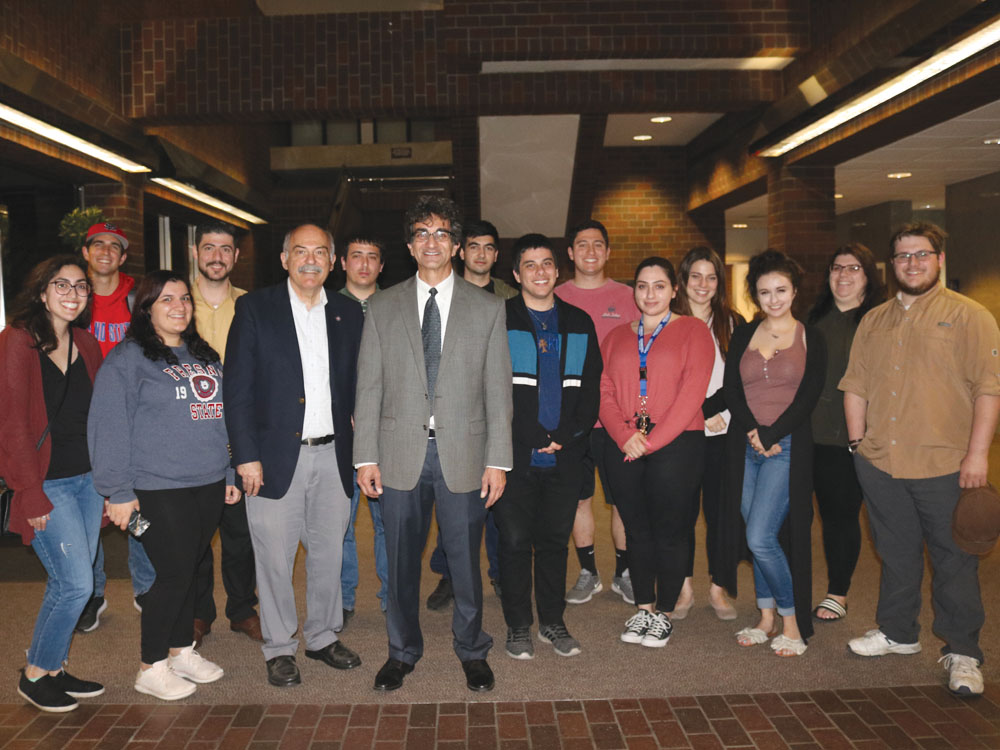
Photo: Andrew Hagopian
Arshak Abelyan
Staff Writer
The borders and barriers imposed by empires have created names which have divided the Armenian homeland for centuries. The designation “Armenian Highland” was purged from maps beginning in the 1940’s, and earlier the Armenian Genocide had attempted to completely eliminate the Armenian people. Matthew Karanian wanted to celebrate the history and culture of the Armenians and preserve the Armenian Highland in his new book, The Armenian Highland: Western Armenia and the First Republic of Armenia, 1918.
Karanian was a guest speaker for the Armenian Studies Program Spring Lecture Series on Thursday, April 11, when he gave a presentation about his work and about his new book The Armenian Highland before an enthusiastic audience at the University Business Center, at Fresno State.
Karanian began his journey to write The Armenian Highland in order to discover the history of surviving members of his family following the Armenian Genocide. Karanian’s grandfather, Hovhannes Karanian, was from Aykestan, Van, and after arriving in New Britain, Connecticut, had placed an ad in the Hairenik newspaper seeking information about his family.
“What my grandfather was doing a century ago, was reaching out to anybody who knew his family, anybody with information about his hometown, anyone with information about his homeland,” said Karanian. “I think it is entirely fitting that 100 years later, I am doing the same thing.”
Karanian’s grandmother Agnes on the other hand, was deported in the summer of 1915 from Zara, Sepastia, without the chance to say goodbye to her home. She ultimately survived the Genocide and settled in Rhode Island. She constantly expressed her desire to once again see her home.
“The history of my grandparents intrigued me,” said Karanian in the book’s introduction. “It led me to ask further questions about their lives first as Armenians, and then as refugees, and finally as Americans. The research for this book was part of my search for the answers.”
Karanian wanted to bring some closure for his grandparents and to be able to say goodbye for his grandmother through the book.
Karanian felt compelled to share and publicize the documents and photos of the Armenian Highland, which he started to compile in 1995. He emphasized his own mission in his documentation and journey by saying that, “we should document what we still have, show that we still have interest in the land, and persuade the local people that there is a benefit in preserving the land instead of destroying it.”
On his trips to the Armenian Highland, Karanian was accom-panied by a Turkish-speaking member in the group, who was able to communicate and find Armenians in the regions they visited. Karanian is often asked, if Western Armenia would become part of Armenia, what would we do with it? Would any Armenians go back? “Armenians are already there, and they can help us preserve the cultural artifacts of these sites,” responds Karanian.
On another trip in 2017, Karanian was inspired by a school teacher named Laura Gaboudian, whose goal was to find her great grandfather’s house in Havav. Skeptical and very doubtful about her idea at first, he ended up going with her on a one-day trip. She used a hand-drawn map from a genocide survivor from Havav to find the location of her family home.
However, it was one month too late, as the original house was destroyed by a Turkish man, Sharif Sherifoglu and his brother Mehmet, who lived with their families in a new modern house that had taken its place. Sherifoglu claimed to have an Armenian grandmother who lived in the same house. DNA tests were taken and surprisingly it turned out that Gaboudian and Sherifoglu did have a common ancestor.
It may seem like most Armenian architectural structures have been already been destroyed and ruined by the Turkish state and treasure seekers, but there still are some preserved churches and khatchkars left on the Armenian Highland. There are also Kurds and Turks with some Armenian blood. Karanian believes that building bridges with locals in those sites will help preserve the Armenian culture and art in the Armenian Highland. With his book, The Armenian Highland, Karanian attempted to show “what we had, what we still have, and to encourage each of us to take ownership of our homeland.”
Karanian’s journey has led him to a greater understanding of the Armenian nation, which he said was his reward. There are many people who are documenting historic Armenia, but “… I created this book in order to share this reward with others—to show that the Armenian homeland still exists and that this homeland and grandparents deserve to be remembered. Even after more than 100 years.”
Matthew Karanian is a lawyer and author of many books, including The Stone Garden Guide: Armenia and Karabagh (2004) and Edge of Time: Traveling in Armenia and Karabagh (2002).
In 2016, he was a recipient of the Arshile Gorky Medal from the Republic of Armenia for his service to homeland and for his role in helping to serve as a bridge between the homeland and the worldwide diaspora of Armenians.
Armenian Highland (Stone Garden Press, 2019), 312 pages, with color photographs, has seven chapters: The First Republic; Ani; Kars; Van; Diyarbakir; Bitlis and Erzerum; and Kharpert and Sebastia.
The book is available through Amazon or at historicarmeniabook.com.
 Hye Sharzhoom Armenian Action
Hye Sharzhoom Armenian Action